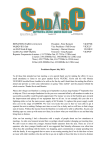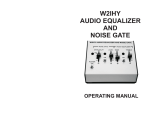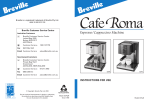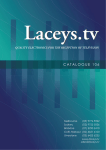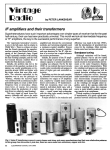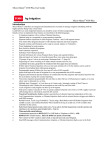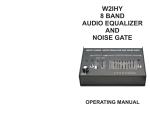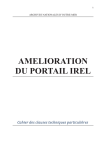Download August 2012 - Shepparton And District Amateur Radio Club
Transcript
REPEATERS VK3RGV 2m & 70cm VK3RGV B D-Star 2m IRLP Node # 6992 CLUB CALL SIGN VK3SOL President:- Peter Rentsch Vice President:- Ed Roache Secretary:- Alan Treasurer:- Ron Burns VK3FPSR VK3BG VK3AO VK3COP DISCLAIMER. No guarantee is given as to the accuracy of information in this newsletter. Warning:- There is a danger of electrocution or injury when working on electrical/radio gear. You do so at your own risk. Presidents Report August 2012. A good roll up for our August meeting. Thank you to all those who attended and I hope you enjoyed the meeting. Thank you to Rodney VK3UG for his presentation on interference and the causes of the phenomena. The Murray QUAD, an event consisting of a 3.5k Swim, a 20.5k run, a 90k bike ride and a 26k paddle will be held on Saturday, 15th December 2012. The event will commence in Yarrawonga and conclude in Tocumwal. The Club voted in favour of being involved in this event in regard to carrying out the Comms for the day. We will need 12 to 15 operators to cover the day most of which will be along the Murray River from Cobram to Tocumwal. I attended a meeting of the major stake holders on Sunday 19th August in Yarrawonga and I will report back to our September meeting on what our role will be. It should be a good fun day albeit very busy. It is a great opportunity for us to promote Amateur Radio to the Community and to further use our equipment in a fulfilling and professional manner. To all those who have paid their Membership fees, thank you very much. To those that have not paid please do so at your earliest convenience. Membership fees were due on the 1st July and I would like to have them all paid by the completion of the Hamfest. To continue to receive the Club Newsletter and receive you discount at Jaycar memberships need to be paid by the completion of the Hamfest. Membership fees help cover the expenses of running the Club and maintaining our equipment so they are all greatly appreciated. At the last meeting I reported that the Website still had not been updated. This has now been rectified and it should be relatively up to date. I have placed information on the Website about the upcoming Hamfest so at least those from other areas can be brought up to date. I have done a lot of quick changes to the Website and have now passed the details of accessing the site to Steve VK3DAG who has agreed to maintain it. Please be a little patient with the changes as they are quiet time consuming to do and very easy to miss one of the links. Thank you Steve VK3DAG for offering to do the work on the site. Finally don’t forget out Hamfest to be held on Sunday 9th September. All those that can help will be greatly appreciated. This is our major fundraising event for the year so a concerted effort by all to make a successful day will be beneficial to the Club and your enjoyment of Amateur Radio. We will need to be there to set up at 7.00am so as we can allow the traders in to set up at 8.00am. Public is allowed in at 10.00am. Traders tables are still available and these are $10.00 each. Entry to the day for the public will be $5.00. Please also remember at the conclusion of the Hamfest we need you stay to clean up the building. I realise that you are all keen to get home to try out your latest purchase but if we all stay to clean up it will not take very long. Thank you in anticipation for your support of the Hamfest and I look forward to seeing as many of you as possible at the next meeting on the 1st September where final arrangements will be made for the Hamfest on the 9th September. Peter – VK3FPSR President – SADARC Minutes of the Shepparton and district Amateur Radio Club 4th August, 2012 As Alan VK3AO was an apology Rod, VK3UG took the minutes. Meeting commenced at 1.04pm. President Peter passed on the condolences of the Club to Ron VK3COP on the passing of his wife. Apologies were received from AlanVK3AO, Pat VK3OV, Alan VK3FALN, Ed VK3BG, Bob VK3GEB, Jan VK3ALF, Ian VK3CHV and Steve VK3DAG. Minutes of the last meeting were handed out. Moved John VK3FJHM, Seconded Mike VK3FMAA as a true and correct record. Minutes were passed. Inwards Correspondence. QSL Cards Membership payments. Email from a non member in regard to QSL cards Outwards Correspondence Letters to Commercial exhibitors in relation to making a donation for the upcoming Hamfest. Ron VK3COP presented the Treasures report. Moved Ron VK3COP, seconded John VK3PXJ as a true and correct record. The treasures report was passed. Rod VK3UG and Phil VK3ELV presented a technical report. Moved Rod VK3UG and seconded Ron VK3COP as a true and correct record. The technical report was passed. General Business: Hamfest John VK3PXJ reported that 16 tables had been booked for the Hamfest. Trevor VK3VG was asked to contact TV and Radio stations to promote the Hamfest Set up of the Hamfest will be Sunday Morning as we do not have access on Saturday. Rod VK3UG to follow up possible Radio Australia visit at 2.00pm Sunday. Rod to advise Peter VK3FPSR of the outcome Jack VK3TJS has the catering in hand Pat VK3OV will organise the key for the St Augustine’s Hall. Peter VK3FPSR will organise the Public Address System Mike VK3FMAA will with assistance of Matt SWL create a Power Point Presentation promoting the sponsors. The website has still not been updated. Peter VK3FPSR will continue to follow this up. (Has since been done) The Murray QUAD event to be held in December that the members will be doing the Comms for, is still occurring. No further information has yet been received. Peter VK3FPSR will attend a meeting of the stake holders for the event in Yarrawonga on Sunday, 19th August and report back at the next meeting. Next meeting will be Saturday 1st of September. 1.00pm Mooroopna Guide Hall. The meeting closed at 2.15pm. Following coffee Rod VK3UG presented a talk on dealing with interference. Thank you Rod. INTERFERENCE TO AND FROM AMATEUR RADIO EQUIPMENT This is a short article and as a result I cannot go into great detail on sources and cures. However, I have given a few examples. I hope that I can give readers a better understanding of how interference is caused and in general how the interference may be minimised. I say minimised as it becoming more difficult to completely overcome interference. Even if you were to live out back of beyond with no one within 100 kilometres you could still suffer from manmade noise/interference. Here is an example. Quite a few years ago I lived in an area where SEC power lines did not exist and most local communities had a local power station that supplied power within the town limits. I was a volunteer with the local CFA and used HF radio on 2692 kHz along with the others in the group. At one stage we were getting interference to our reception around the district well away from power lines (20 or 30 kilometres at least) and the interference they can cause). The problem was power line interference. Interference is another radio wave and in this instance a severe problem on a power line somewhere or other created the interference and it was radiated, then reflected off the ionosphere and we copped it on the CFA radio network. Interference sources have been around since the start of time, as our solar system has enormous electrical activity occurring in it all the time. We are aware of electrical storms and the effects of solar disturbances on our communications. If you use two metres SSB with a sensitive low noise receiver, have a high gain antenna and point the antenna at the sun you will observe a noticeable increase in the noise level in your receiver. The sun is a good noise producer. When wireless/radio communications started back in the very late 1800s interference was there already from the natural sources mentioned above, to manmade interference created by the relatively new electrical machinery. Early communications with spark transmitters using Morse code was in reality done by controlling the interference generated by the spark transmitter at the rate the Morse was sent. So interference in one form or another has been around all the time. Our aim is to be able to communicate despite the probable presence of interference. This is done by eliminating the interference, removing our equipment from the area where the interference is located and designing our equipment to reject interference. The methods we may adopt may be any one of the aforesaid items or the use of all three methods. From my experience all three methods are used together whether we recognise it or not. Whilst a source of interference may be suppressed, other sources which we cannot get access to or locate will still give interference. This is when we need to use circuit and station design concepts like, frequency of use (VHF versa HF), mode of use (e.g. FM), noise limiters and blankers, directional antennas, noise reducing antennas and physically removing the location of our station away from the sources (portable operation). Natural sources of interference to our communications and how to minimise their effect. A source likely to disrupt high frequency long distance communications is static or electrical storms. These may be quite local or are perhaps hundreds of kilometres away. A variety of circuits in our receivers can deal with static crashes with varying degrees of success. Interference of this type is non-coherent and varies in amplitude rapidly. The earliest methods used to alleviate this interference have been and are noise limiters. These are usually located in the audio amplifier of the receiver and often take the form of biased diodes that clip any audio signal above a certain level. These may be automatic whereby the receiver AGC voltage sets the clipping level or it may be a purely physically set level done by the operator. Some receivers even have two back to back diodes across the headphone output and the level for clipping is set purely by the voltage that the diode requires to conduct, usually around 0.15 volts for germanium and around 0.6 volts for silicon diodes. The effectiveness of these limiters depends not only on the volume of the audio signal but also the selectivity of the IF amplifier. The higher the selectivity the less effective is the limiter. These particular limiters are really best used on AM transmissions and are not as effective for single side band. In more recent times noise blankers have become popular. As mentioned in the previous paragraph the receiver selectivity does have a bearing on the effectiveness of noise limiters. Narrow bandwidth IF amplifiers stretch noise pulses and make the effectiveness of noise limiters poor. A receiver with a broad IF amplifier does not stretch the interference pulses to any extent which means the limiters work quite satisfactorily. Narrow IF bandwidths, as our SSB receivers have, necessitate the use of noise blankers. These work by taking and amplifying a sample of the incoming signal before the high selectivity section of the receiver. This signal will also have the interference present on it too. The interference causes an electronic gate to shut preventing the interference being passed onto to the selective IF amplifier where pulse stretching and ringing of the filter occurs. These can be quite effective but like limiters there are blankers and blankers. Interference generated on power lines and many other sources can be minimised by the use of the limiters and blankers too. Unless things have changed in the last few years, it is possible to complain to the power companies about interference and have it corrected. However, it behoves you as an amateur to be quite sure that you can readily identify the problem as power line related, but not necessarily where it is coming from, and that it is not something that is just transported along the power lines and radiated from them. Which antennas pick up the least interference and why. The electromagnetic waves that make up our radiated signals consist of two components an electric field and a magnetic field. They are equal in intensity and are at 90 degrees to each other. The plane of the electric field is vertical with a vertically polarised antenna and horizontal with a horizontally polarised antenna. Vertical antennas are the most prone to picking up interference which may be because interference is more likely to be vertically polarised. Horizontal antennas tend to pick up less interference, and they have the additional benefit of directivity whereby if you are lucky you can orientate your antenna to pick up less interference. Both of these types of antenna respond more to the electric field than the magnetic field. Quite a few years ago Drew Diamond designed a noise cancelling antenna matching device for use on HF. It worked on the principle of having a small antenna that was purposely run around and through the noisy environment of the home, whilst the main transmitting and receiving antenna was in as clear an area as was possible. By combining the signals from both antennas, phasing the signals and adjusting the level of the interference from both antennas it was possible in some instances to reduce the level of the interference. It works a bit like a noise cancelling microphone. This can be used with both vertical and horizontally polarised antennas. Now there is another antenna which although rarely used is largely clear of interference whilst either vertical or horizontal antennas in the same location may suffer badly with interference. What is it you may ask? It is the loop antenna. A loop antenna responds more to the magnetic component of an electromagnetic wave. In the near vicinity to the interference source the electric field is stronger than the magnetic field. Don’t ask me why this is so as I’ve asked those giving lectures on the subject and they are unable to tell me either. It is claimed that the loop antenna needs to be much smaller than wavelength for the noise reducing characteristics to be prominent. Many claim that a quad antenna is largely immune to electrical interference. I don’t have experience with quads to make a comment, but they may be well worth a try. I do have experience on the broadcast band with small area loops and interference is almost non-existent in many instances when they are used, whilst a similar ‘long’ wire picks up quite a bit of interference. Loop antennas are nowhere near as efficient at radiating signals from a transmitter when compared to a vertical or horizontal antenna, plus there are problems in making these antennas so that they are reasonably efficient. If it were easy with our current transceivers to be able to conveniently switch the set to a dipole or a vertical on transmit and the receiver to use the loop antenna things would become interesting. Additionally the loop is an extremely high Q antenna with very high circulating currents in the loop and very sharp tuning, possibly sharper than an 80 metre loaded mobile whip. Some sets have an auxiliary output line for use with linears and other facilities and it would be practical to have the antenna switch automatically between a loop for receive and a dipole for transmit. The only problem here is that if you press the transmit PPT and talk straight away or use CW or FM the transmitter may transmit into the loop for a short time until the relay does the changeover to the dipole. The arcing at the relay contacts and the variation in the loading of the transmitter are both undesirable situations, plus interference would be radiated every time that the PTT was pushed. Someone may be able to devise a sequencing system for the relay switching – anyone want to take this project on? I know I’d be interested in the results of someone’s experiments. What causes interference to our receivers? There are as many sources of interference as there are different active devices. Broadly we have power line interference, interference from various electronic gismos and natural interference from electrical storms. Interference can be either coherent or non-coherent, with power line and electrical storms falling into the latter category. Interference from electronic gismos – computers, toys, power supplies, some solar inverters, hair dryers, Plasma TV sets, vehicle ignition systems, etc may be either coherent or non-coherent interference sources or both. Coherent interference is usually something like a carrier generated by the clock in a computer or some other stable or unstable, intended or unintended RF generator. Non-coherent interference is interference like an electrical storm or power line interference. It is broad band with no defined carrier. With electronic gismos there are two methods of solving or reducing the interference generated. Some interference is directly radiated from the offending device and some is conducted along power or other electrical leads and radiates from them. With direct radiation, a rule of thumb is shield the device so interference cannot get out of it or rectify the source of interference if at all possible. With conducted and then radiated interference line filters of various sorts can be quite effective. Computers can cause interference to our amateur receivers. The problems may come from the power supply or from the computer proper. Wherever possible make sure that the computer case is metal and joins make good metal to metal contact with each other. It may be practical to place aluminium kitchen foil over various leads and bond these to the main cabinet and to the peripheral device. This is messy but may be the only thing you can do. Sometimes using a ferrite rod (the type used in portable radios – preferably around 6 to 8” long) and wrapping the offending cable around it can work too, particularly if the cable is a curly cord anyway. The cable needs to be taped to the ferrite rod. Mains filters may assist although most computers already have some filtering on the mains cable. It may be that the coaxial cable attaching the receiver to the antenna is transferring the interference up to the antenna on the outside of the braid. In which case it may be desirable to use a balun at the antenna feed point and perhaps wrap several turns of the coaxial cable around and through a toroid ring down in the shack. Each separate situation will often demand a different approach. I’ve only talked about interference to amateur equipment. However, amateur equipment can generate spurious signals but generally amateur equipment is blameless, but interference to TV for example may occur. As was said at the meeting where this talk was given a member was having trouble with his transmitter causing his TV to black out on all the HF bands he can operate on. He believes that the mast head amplifier is at fault. The ideal thing to do here to be quite sure if it is the amplifier or the TV is to try another TV in place of the existing set. If the interference clears, the TV is at fault but if it continues it could be the amplifier or something near it causing it. Most mast head amplifiers are a broadband device, which means they will amplify most signals and can be easily overloaded. The first place to start with is to check that the TV antenna and the coaxial cable (double shielded at least) to the amplifier are in GOOD order with no corrosion. If corroded it/they should be replaced. As digital TV is only transmitted from 174 MHz to around 850 MHz it is desirable to have an antenna system that suits only this range of frequencies, or the specific channels we have in the area of reception. If the antenna and cable is now in good condition or is replaced, give the system another try to see if interference occurs. If it still does it may be time to look carefully at the amplifier, and if it is an older type it may be time to give your TV system a birthday and fit an amplifier that only works between 174 and 850 MHz. Kingray have some good amplifiers but be wary of Chinese units as some are quite noisy. An amplifier that only responds to this range of frequencies is going to be able to reject signals below 174 MHz fairly well. Assuming that the coaxial cable after the amplifier down to the set is in good order with at least double shielding, with no further mucking around the TV set should perform well. However, if interference is still evident more drastic measures will need to be taken, and these can take the form of putting the coaxial cable through a toroid ring (50 mm diameter approx) as many times as it will fit either at the output of the amplifier or near the bottom of the coaxial cable run to the TV set. I can run my monitor TV set right alongside my amateur equipment and there is no interference on any bands even when running 100 watts on two metres. Summary Quite a bit of equipment have compliance stickers on them indicating that they meet European, American or Australian standards. Therefore they will not emit any interference. WRONG as compliance stickers are very easy to obtain on a roll and placed on equipment and some of this equipment generates so much interference that it can even wipe out quite local radio stations. This tends to apply to cheap imported equipment but not always. A lot of the equipment labelled does comply with the particular standard that the sticker claims. I’ve only touched on a few basics and only experience and experimentation will assist anyone with interference problems. Sometimes it will be desirable to have another amateur assist you when you are trying to trace interference, as you may need to be in two places at the one time. Also two people have more chance of success. If the interference source is in a neighbours place be very careful how you approach them if you want co-operation in dealing with interference problems. I will assist members where I can, but I am limited in the amount of time that I can give to tracing and correcting problems. Rodney Champness VK3UG SADARC Hamfest 2012 Shepparton 9th September Doors Open at 10.00am St Augustines Hall Orr St Shepparton . Vic roads map 273 Ref M8. Entry fee $5.00 Contact Bookings John VK3XPJ, email [email protected] Alan VK3AO, email [email protected] Phone 03 5824 1188 or mobile 0400 289 671 The annual Shepparton and District Amateur Radio Club Comms Day/ Hamfest will again be held on Sunday 9 September, 2012. Great door prizes plus a raffle will be held. And Don’t forget our great food. The following traders will be in attendance: Strictly Ham TTS Systems HAMAK Jaycar NBS Antennas Radiobooks.com.au Plus many other tables of pre loved equipment will be there. See you on Sunday 9th September in Shepparton. th FOR SALE ICOM 765 HF TRANSCEIVER Had new since 1993, it is a one owner HF full featured radio. One of the best units of its day. It has been kept in excellent condition and recently had an intermittent faulty relay replaced and given a full BFO alignment and it sounds as good as the day I bought it. Comes with HM36 hand microphone, and Instruction and service manual as well as other paperwork off the internet regarding mods and fixes etc. Comes in the original box too! This is a reluctant sale as it is an excellent DX radio with a very sensitive receiver, but it has to go, as I make some room in the shack, because I already have a main HF radio and also a backup. I am advertising it here first for club members, and if it does not sell I will put it on the club table at the 2012 SADARC Hamfest. Read the reviews on eham.net and it shows that it was one of the best Icom rigs ever made. Yours for only $800 ONO (This radio cost $4750 when new in 1993 and was second only to the mighty ICOM 781 costing $10,000!) Les VK3TEX, I can be contacted on mobile number 0407829098 or email at [email protected].









